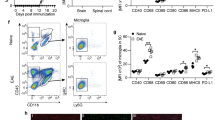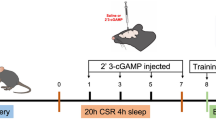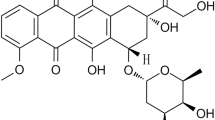Abstract
Since 1983, Dimebon (Dimebolin) is used clinically in Russia as an antihistamine drug. Recent interest in Dimebolin is associated with its therapeutic effect in patients with Alzheimer’s disease. Animal studies have shown that Dimebon activity is realized via multiple mechanisms. Our experiments performed on the fibroblast cell culture L929 and C57Bl mice have been shown that Dimebon may block cytotoxic signals induced by the proinflammatory cytokines, tumor necrosis factor α (TNFα). Dimebon (10 μg/mL) protected mouse fibroblast cells L929 against toxic action of TNFα. Pretreatment of mice with Dimebon prevented development of changes in molecular species of sphingomyelins and galactosylceramides induced by a single dose administration of TNAα. Dimebon itself did not induce changes in sphingolipids of the investigated brain structures.
Similar content being viewed by others
References
Matveeva, I.A., Farmakol. Toksikol., 1983, vol. 46, pp. 27–29.
Bachurin, S., Bukatina, E., Lermontova, N., Tkachenko, S., Afanasiev, A., Grigoriev, V., Grigorieva, I., Ivanov, Y., Sablin, S., and Zefirov, N., Ann. N.Y. Acad. Sci., 2001, vol. 939, pp. 425–435.
Doody, R.S., Gavrilova, S.I., Sano, M., Thomas, R.G., Aisen, P.S., Bachurin, S.O., Seely, L., and Hung, D., Lancet, 2008, vol. 372, pp. 207–215.
Ustyugov, A.A., Shelkovnikova, T.A., Kokhan, V.S., Khritankova, I.V., Peters, O., Buchman, V.L., Bachurin, S.O., and Ninkina, N.N., Byul. Eksper. Biol. Med., 2011, vol. 152, pp. 675–678.
Khritankova, I.V., Kukharskii, M.S., Lytkina, O.A., Bachurin, S.O., and Shoring, B.Y., Dokl. Biol. Sci., 2012, vol. 446, pp. 471–473.
Steele, J.W. and Gandy, S., Autophagy, 2013, vol. 4, pp. 617–618.
Shevtsova, E.F., Kireeva, E.G., and Bachurin, S.O., Byul. Eksper. Biol. Med., 2001, vol. 132, pp. 652–656.
Shevtsova, E.F., Kireeva, E.G., and Bachurin, S.O., Vestn. RAMN, 2005, no. 9, pp. 13–17.
Burns, A. and Jacoby, R., Lancet, 2008, vol. 372, pp. 179–180.
Sachdeva, D. and Burns, A., CNS Neurosci. Ther., 2011, vol. 3, pp. 199–205.
Fiers, W., FEBS Lett., 1991, vol. 285, pp. 199–212.
Vassali, P., Ann. Rev. Immunol., 1992, vol. 10, pp. 411–452.
Smith, J.A., Das, A., Ray, S.K., and Banik, N.L., Brain Res. Bull., 2012, vol. 87, pp. 10–20.
Cacquevel, M.L., Lebeurrier, N., Chéenne, S., and Vivien, D., Curr. Drug Targets, 2004, vol. 5, pp. 529–534.
Montgomery, S.L. and Bowers, W.J., J. Neuroimmune Pharmacol., 2012, vol. 7, pp. 42–59.
Arvin, B., Neville, L.F., Barone, F.C., and Feuerstein, G.Z., Neurosci. Biobehav. Rev., 1996, vol. 20, pp. 445–452.
Clark, I.A., Alleva, L.M., and Vissel, B., Pharmacol. Ther., 2010, vol. 128, pp. 519–448.
Hoffmann, O., Zipp, F., and Weber, J.R., J. Mol. Med. (Berl), 2009, vol. 87, pp. 753–763.
Rubio-Perez, J.M., and Morillas-Ruiz, J.M., Scientific World Journal, 2012, vol. 2012, pp. 1–15.
Perry, R.T., Collins, J.S., Wiener, H., Acton, R., and Go, R.C., Neurobiol. Aging, 2001, vol. 22, pp. 873–883.
McAlpine, F.E. and Tansey, M.G., J. Inflamm. Res., 2008, vol. 1, pp. 29–39.
Rozhnova, U.A., Stepanichev, M.Yu., Korobko, V.G., Gulyaeva, N.V., and Alessenko, A.V., Neurochem. J., 1999, vol. 16, pp. 302–309.
Osburg, B., Domling, D., Schomburg, L., Ko, Y.T., Voigt, K., and Bickel, U., Am. J. Physiol. Endocrinol. Metab., 2002, vol. 283, pp. 899–908.
Engelhardt, B., J. Neural Transm., 2006, vol. 113, pp. 477–485.
Giri, R., Shen, Y., Stins, M., Schmidt, A.M., Stern, D., Kim, K.S., and Kalra, V.K., Am. J. Physiol. Cell Physiol., 2000, vol. 279, pp. 1772–1781.
Adibhatla, R.M. and Hatcher, J.F., Subcell. Biochem., 2008, vol. 49, pp. 241–268.
Tweedie, D., Sambamurti, K., and Greig, N.H., Curr. Alzheimer Res., 2007, vol. 4, pp. 378–385.
Tettamanti, G., Prinetti, A., Bassi, R., Viani, P., Giussani, P., and Riboni, L., J. Lipid. Mediat. Cell. Signal., 1996, vol. 14, pp. 263–275.
Martinez, T., Chen, X., Bandyopadhyay, S., Merrill, A., and Tansey, M., Mol. Neurodegener., 2012, vol. 13, pp. 7–45.
Jana, A., Hogan, T.L., and Pahan, K., J. Neurol. Sci., 2009, vol. 278, pp. 5–15.
Barth, B.M., Gustafson, S.J., and Kuhn, T.B., J. Neurosci. Res., 2012, vol. 90, pp. 229–242.
Wheeler, D., Knapp, E., Bandaru, V.V.R., Wang, Y., Knorr, D., Poirier, C., Mattson, M.P., Geiger, J.D., and Haughey, N.J., J. Neurochem., 2009, vol. 109, pp. 1237–1249.
Alessenko, A.V., Biomed. Khim., 2013, vol. 59, pp. 25–50.
Tobinick, E., CNS Drugs, 2009, vol. 23, pp. 713–725.
Frankola, K.A., Greig, N.H., Luo, W., and Tweedie, D., CNS Neurol. Disord. Drug Targets, 2011, vol. 10, pp. 391–403.
Bligh, T.G. and Dyer, W.J., Can. J. Biochem. Physiol., 1959, vol. 37, pp. 911–917.
Alessenko, A.V., Bugrova, A.E., and Dudnik, L.B., Biochem. Soc. Trans., 2004, vol. 32, pp. 144–146.
Alessenko, A.V., in New Research on Alzheimer’s Disease, Welsh, E.M., Ed., Nova Science Publishers, Inc., 2006, pp. 168–189.
Author information
Authors and Affiliations
Corresponding author
Additional information
Original Russian Text © A.V. Alessenko, S.O. Bachurin, S.V. Gurianova, Y.O. Karatasso, E.F. Shevtsova, L.N. Shingarova, 2015, published in Biomeditsinskaya Khimiya.
Rights and permissions
About this article
Cite this article
Alessenko, A.V., Bachurin, S.O., Gurianova, S.V. et al. Tumor necrosis factor-alpha is a potential target for the neuroprotector Dimebon. Biochem. Moscow Suppl. Ser. B 9, 189–198 (2015). https://doi.org/10.1134/S199075081502002X
Received:
Published:
Issue Date:
DOI: https://doi.org/10.1134/S199075081502002X




